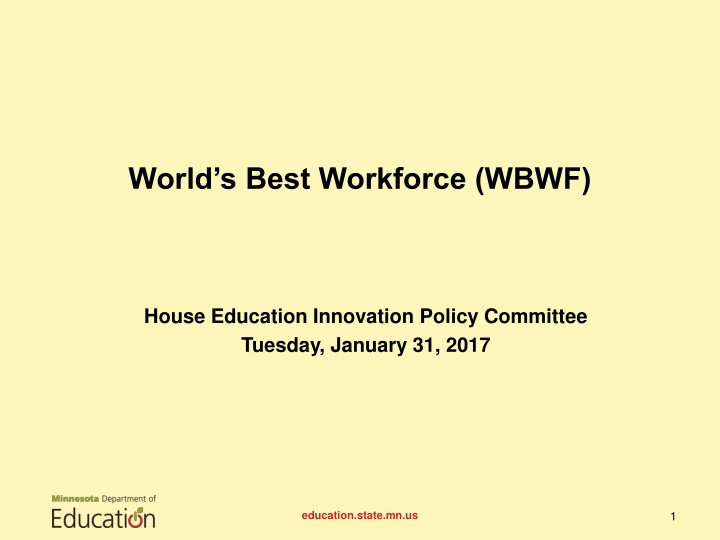
Creating a Strong Education Plan with Worlds Best Workforce (WBWF)
Explore the Worlds Best Workforce (WBWF) initiative, designed to enhance education through strategic planning and goal-setting. Learn about the legislation, process, annual reporting, and measures involved in ensuring student success and achievement. Discover how districts set goals, track progress, and address key educational milestones with the support of the Minnesota Department of Education.
Download Presentation

Please find below an Image/Link to download the presentation.
The content on the website is provided AS IS for your information and personal use only. It may not be sold, licensed, or shared on other websites without obtaining consent from the author. If you encounter any issues during the download, it is possible that the publisher has removed the file from their server.
You are allowed to download the files provided on this website for personal or commercial use, subject to the condition that they are used lawfully. All files are the property of their respective owners.
The content on the website is provided AS IS for your information and personal use only. It may not be sold, licensed, or shared on other websites without obtaining consent from the author.
E N D
Presentation Transcript
Worlds Best Workforce (WBWF) House Education Innovation Policy Committee Tuesday, January 31, 2017 education.state.mn.us 1
WBWF Goals WBWF legislation passed in 2013. School boards are to develop a long-term, strategic plans to reach the five WBWF goals. All Students Ready for Kindergarten All Third Graders Proficient in Reading All Achievement Gaps Closed All Students Graduate from High School All Students Career and College Ready All public districts and charters are included. education.state.mn.us 2
WBWF Process School boards 1. Adopt a comprehensive, long-term strategic plan to support teaching and learning. Advisory Committee established. Not submitted to MDE. 2. Publish an annual report. Reflecting on previous year and planning forward. Not submitted to MDE; Posted to website. 3. Hold an annual public meeting. Reflecting on previous year and planning forward. 4. Develop a brief summary of the annual report. Reflecting on previous year. Submitted to MDE. education.state.mn.us 3
WBWF Annual Report Summaries To provide standard, meaningful feedback, MDE developed a template for all districts to submit information and a rubric that is used by MDE reviewers. 2015-2016 summaries were due Dec 15, 2016. MDE reviews began on January 4, 2017. Feedback will be sent to districts in March 2017. education.state.mn.us 4
MDE Work to Meet WBWF Legislation 62 MDE staff members currently reviewing district summaries. MDE staff member coordinates the review process and provides training to reviewers. Two administrative positions support the collection of summaries (via email) and dissemination of feedback to districts. Data analytics team runs the data and compiles the data profiles. MDE staff member leads the technical assistance for districts as well as the development of guidance resources. education.state.mn.us 5
WBWF Measures Districts have flexibility to establish WBWF goals and benchmarks using local or state metrics. Many districts choose to use local measures to set goals and track progress. Quality and rigor of local goals vary across the state. Types of assessments and metrics used also differ. MDE requests SMART goals. Specific and strategic Measurable Attainable (yet rigorous) Results-based Time-based education.state.mn.us 6
Example Goals from Districts Kindergarten Readiness Achievement Gap Closure Career/College Readiness Third Grade Reading Graduation education.state.mn.us 7
WBWF Data Profiles MDE has some data available at the state that was provided in WBWF data profiles. District and regional data was provided in October 2016. WBWF Data Profiles are found here: MDE Homepage > Districts, Schools and Educators > World s Best Workforce http://education.state.mn.us/MDE/dse/wbwf/ Based on ECSU regions, found here: w20.education.state.mn.us/MdeOrgView/groupTag/standardDisplayHeads/ECSU http:// education.state.mn.us 8
Regions Used for Data Profiles education.state.mn.us 9
State WBWF Data Profiles Measures Provided by MDE MDE has a menu of valid and reliable tools districts can use to assess Kindergarten readiness. Data not available statewide. All Students Ready for Kindergarten By student group: Grade 3 reading percent proficient in 2016 Grade 3 reading 2017 goal Grade 4 reading growth scores All Students in Third Grade Achieving Grade-Level Literacy By student group: Math and reading proficiency compared to targets to reduce gap by 50% by 2017 Indicates if districts met targets in 2016 Close the Achievement Gap(s) Among All Groups All Students Career- and College-Ready By student group: Grade 8 math percent proficient Grade 8 math 2017 goal By student group: 2015 graduation rates Increase needed to reach 90% goal by 2020 All Students Graduate 2016 data on the percent of inexperienced teachers and percent of classes taught by unqualified or out Equitable Access to Excellent Teachers education.state.mn.us of field teachers 10
WBWF Focus Groups MDE conducted seven focus groups across the state to solicit feedback from districts on the implementation of WBWF Participants included superintendents, principals, teachers, data coordinators, and other district administrators education.state.mn.us 11
Successes Learned from Focus Groups Districts are Integrating WBWF engagement activities with existing community activities. Increasing partnerships with local mental health services and local businesses for mentoring/training. Aligning WBWF goals with the district strategic plan, making WBWF part of the overall district focus. Increasing their knowledge of the assessment options, which inform districts assessment selection and is inspiring some to change their assessment tools. education.state.mn.us 12
Challenges Learned from Focus Groups Districts have Found determining local measures challenging, given the diversity of student needs. Struggled to access kindergarten readiness data. Found that determining the proper assessment tool for tracking student progress toward each goal challenging. Struggled to provide enough professional development to support classroom changes driven by WBWF. education.state.mn.us 13
Items for Consideration Based on Lessons Learned Improve the data-driven definition of career and college readiness. Support inter-district communication to share experiences, successes, and challenges. Align state WBWF and federal ESSA systems to build a cohesive system around common goals. education.state.mn.us 14
Thank you education.state.mn.us 15
